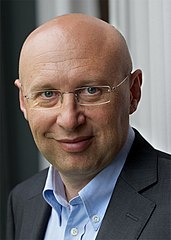Stefan Hell
 2010 | |
| Data i miejsce urodzenia | |
|---|---|
| Zawód, zajęcie | |
Stefan Walter Hell (ur. 23 grudnia 1962 w Aradzie[1]) – rumuńsko-niemiecki fizyk, laureat Nagrody Nobla w dziedzinie chemii w 2014 roku[2].
Życiorys
W wieku piętnastu lat wyemigrował z rodzicami do Niemiec (1978). W roku 1981 rozpoczął studia fizyki na Uniwersytecie w Heidelbergu. W roku 1990 uzyskał doktorat w dziedzinie fizyki[3]. W latach 1991–1993 pracował w European Molecular Biology Laboratory, również w Heidelbergu. Następnie był pracownikiem Uniwersytetu w Turku w Finlandii, a także pracownikiem naukowym brytyjskiego Uniwersytecie w Oksfordzie. Od 1997 roku związany jest z Max-Planck-Institut für biophysikalische Chemie w Getyndze, którego został dyrektorem w 2002 roku. Jest honorowym profesorem fizyki doświadczalnej na Uniwersytecie w Getyndze. Od 2019 jest członkiem Papieskiej Akademii Nauk.
Życie prywatne
Od roku 2000 żonaty, jest ojcem czworga dzieci[4].
Nagrody i wyróżnienia
Hell jest laureatem między innymi:
- Nagrody Międzynarodowej Komisji Optyki z 2000,
- Carl-Zeiss Research Award z 2002,
- Nagrody Otto Hahna z 2009,
- Nagrody Rodziny Hansenów w 2011[5],
- W 2014 roku otrzymał (wspólnie z Erikiem Betzigiem i Williamem Moernerem) Nagrodę Nobla w dziedzinie chemii za rozwój mikroskopii fluorescencyjnej wysokiej rozdzielczości[6][7].
Przypisy
- ↑ Autobiography Stefan W. Hell, kavliprize.org (dostęp: 30 października 2014).
- ↑ Stefan W. Hell – Facts, Nobelprize.org [dostęp 2014-10-08] (ang.).
- ↑ Stefan W. Hell Biographical, nobelprize.org
- ↑ Papież: Stefan Walter Hell członkiem Papieskiej Akademii Nauk, vaticannews.va
- ↑ Stefan W. Hell, Mpibpc.mpg.de [dostęp 2014-10-08] (ang.).
- ↑ The Nobel Prize in Chemistry 2014, Nobelprize.org, 8 października 2014 [dostęp 2014-10-08] (ang.).
- ↑ "Lichtmikroskopie in ungekannter Schärfe" - Stefan Hell für Deutschen Zukunftspreis nominiert, idw-online.de [dostęp 2022-02-19].
Media użyte na tej stronie
Autor: Andy Nestl, Licencja: CC BY-SA 3.0
GFP superresolution, optical nanoscopy ( Christoph Cremer, emeritus at Heidelberg university [1])
View of a nucleus of a bone cancer cell: using normal high resolution fluorescence microscopy, it is not possible to distinguish details of its structure (image on the left). Using the two Color Localization Microscopy 2CLM (image on the right) it is possible to localize 70,000 histone molecules (red: RFP-H2A) and 50,000 chromatin remodeling proteins (green: GPF-Snf2H) in a field of view of 470 µm2 with an optical depth of 600 nm. Common fluorescence markers were used.
2CLM is the only optical nanoscopy method that allows position based co-localization of single molecules at high density in a wide field of view using conventional fluorescent proteins such as GFP, YFP, RFP, or other conventional fluorochromes.
Due to its high optical single molecule resolution, 2CLM allows significantly more precise analyses of potential protein interactions than FRET-(Fluorescence Resonance Energy Transfer) technology, which is at present the preferred method for such investigations. This is of particular significance in studies of biomolecular machines (BMMs) within cells: Single BMMS can be analysed, including the number of molecules of a given type; distances between proteins in these BMMs often are substantially greater than those that can be analyzed by FRET (restricted to a maximum distance of only a few nm).
Possible to use conventional, well established and inexpensive fluorescent dyes, from the GFP group, and its dye variants, to the well-known Alexa and fluorescein dyes. Fundamental to SPDMphymod are blinking phenomena (flashes of fluorescence), induced by reversible bleaches (metastable dark states). Individual molecules of the same spectral emission color can be detected.
Publikation: Manuel Gunkel, Fabian Erdel, Karsten Rippe, Paul Lemmer, Rainer Kaufmann, Christoph Hörmann, Roman Amberger and Christoph Cremer: Dual color localization microscopy of cellular nanostructures. In: Biotechnology Journal, 2009, 4, 927-938. ISSN 1860-6768Autor: Bernd Schuller, Max-Planck-Institut für biophysikalische Chemie, Licencja: CC BY-SA 3.0
Portrait of Stefan W. Hell


